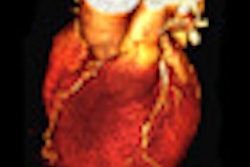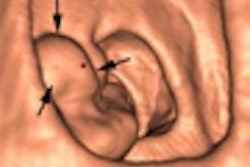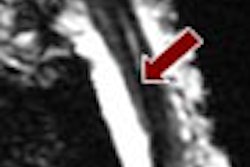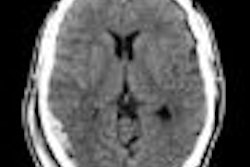VIENNA - Prospective gating has emerged as a promising method for reducing radiation dose in coronary CT angiography (CTA) studies. Monday at the European Congress of Radiology (ECR), Italian researchers confirmed previous results in using prospective gating to reduce dose to as little as 2.8 mSv per heart study, while a German group discussed its effort to further refine prospective gating by making it more accurate.
Concern over radiation dose in multislice CT studies has come to the fore over the past several years, and nowhere is the debate more heated than in coronary CTA. Whether the modality can develop a role in scanning asymptomatic patients with risk factors for heart disease depends in large measure on whether the radiation dose can be reduced to acceptable levels.
One of the most recent dose-reduction technologies is prospective gating, a sequential-scanning step-and-shoot mode in which the x-ray beam only operates during the required heart phases, and is turned off during the rest of the cardiac cycle. Studies presented at the 2007 RSNA meeting indicated that the technique can lower radiation dose from a range of 10-15 mSv in a cardiac study to as low as 1.2-2.2 mSv.
These results were confirmed in a presentation on dose-reduction strategies by Dr. Pietro Spagnolo of the Polyclinic of Monza in Monza, Italy. Spagnolo's group scanned 37 patients with a mean age of 57 years with a 64-slice CT scanner outfitted with a prospective gating technique (SnapShot Pulse, GE Healthcare, Chalfont St. Giles, U.K.).
Seven patients were excluded from the study for factors such as elevated heart rate or arrhythmia. The group administered beta-blockers to 21 patients to reduce their heart rates to an average of 58 bpm.
The researchers found that the prospective gating technique produced an average radiation dose of 3.8 mSv in their patient population. The average radiation dose was skewed somewhat higher due to the inclusion of patients who had received revascularization therapy, such as stents, Spagnolo said. Stents created a blooming artifact in CT studies that required the group to increase the mAs to ensure the production of diagnostic images, she said.
In a subgroup of patients who did not have stents, prospective gating produced an average radiation dose of 2.8 mSv. This compares to 11 mSv for a technetium-based nuclear stress test, 9.4 mSv for a retrospectively gated study with 64-slice CT, 7.8 mSv for a retrospectively gated exam with dual-source CT, and 6.4 mSv for a conventional diagnostic coronary angiogram.
"Prospective ECG gating represents a very promising technique for limiting radiation dose in the vast majority of patients undergoing cardiac MDCT studies," Spagnolo said. "We have to remember the limitations to the use of this protocol, which are the lower tolerance to irregular rhythms and heart rates, and we obtain information from just two phases of the cardiac cycle, so no functional assessment of the left ventricle is allowed."
A new twist on prospective gating
Another presentation in the same session addressed this shortcoming of the prospective gating technique. Christianne Leidecker of the Institute of Medical Physics at the University of Erlangen in Nuremburg compared four different methods for reducing dose in cardiac CT studies to the dose delivered by leaving the tube current on at full strength over the entire scan time.
The methods included the following:
- A spiral scan with ECG-controlled tube current reduced to 20% outside the desired cardiac cycle
- A spiral scan with ECG-controlled tube current reduced to 4% outside the desired cardiac cycle
- A prospectively gated sequential scanning technique similar to that used by Spagnolo's group, in which the duration of the scanning window was set at a predetermined length of time based on the RR length of previous cardiac cycles
- A new adaptive prospective gating technique that used what Leidecker called a "composite pulse," which uses sequential scanning combined with ECG gating to include more parameters in analyzing previous RR cycles, thus varying the duration of the scanning window
"You could have a composite pulse that could vary from heartbeat to heartbeat, and the dose is reduced to zero outside this (scanning window)," Leidecker said.
Leidecker's group tested the technique in simulated CT scans based on 60 ECGs recorded during nonbeta-blocked CT angiography studies (heart rates ranged from 40-103 bpm, and the cardiac phase was assumed to be 70% of the RR cycle). Scans were conducted on a 64-slice CT scanner with a 130-mm scan length and a rotation time of 0.3 seconds.
The researchers then compared the dose reduction and image quality of each of the four techniques. Image quality was determined by matching the full dose plateau of the scanning to the data required for reconstruction, with variations from the ideal rendered in milliseconds.
The group found that for patients with normal heart rhythms (67-71 bpm), the conventional prospective gating technique and the adaptive technique produced similar results. Conventional prospective gating produced a radiation dose that was 23% of a full cardiac CT scan with no tube-current modulation, while the adaptive technique produced 25% of the dose. Conventional prospective gating was slightly less accurate, with 50 msec of cardiac phase error compared to 30 msec of phase error for the adaptive technique.
The two methods varied widely in patients with irregular heart rhythms, however. Conventional prospective gating still achieved a lower dose, at 25% of a full scan, compared to 54% of a full scan for adaptive scanning. But the conventional method also produced a phase error of 320 msec, Leidecker said, compared to less than 30 msec of phase error for adaptive sequential scanning.
Leidecker acknowledged that while conventional prospective gating produced the highest dose savings, the technique was not reliable for patients with heart arrhythmias or other irregularities.
"Sequential scanning provides the highest dose savings, but is least reliable," she said. "The best compromise between dose and reliability is to use a sequential scan with a composite pulse, and this means a dynamic scan length."
By Brian Casey
AuntMinnie.com contributing writer
March 10, 2008
Related Reading
New studies examine CR, CT radiation dose, March 9, 2008
Coronary CTA cuts costs for chest pain care, February 29, 2008
Low-dose coronary CTA diagnoses most patients, November 28, 2007
Radiation dose slashed in 64-slice coronary CTA, February 15, 2007
Step-and-shoot acquisition cuts CTA dose, improves images, January 16, 2006
Copyright © 2008 AuntMinnie.com



















